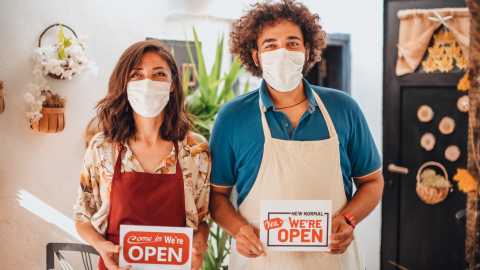 Auto Claims Trends: Frequency, Severity, Repair Costs, and Turnaround Times
Auto Claims Trends: Frequency, Severity, Repair Costs, and Turnaround TimesAround the country, states are easing their COVID-19 restrictions. According to NBC, California has lifted most of its restrictions. This means that masks are no longer mandatory for vaccinated people in most places. It also means that businesses can return to maximum capacity, with no more state rules on social distancing.
For businesses that had to close during the pandemic, this is a big deal. With the green light to reopen, businesses will bring back workers and invite customers and clients to return. First, however, there’s a lot that needs to be done.
Continue Following Health and Safety Guidelines
Although most restrictions have been lifted, the coronavirus remains a threat. Many people are still worried about the virus, and businesses still face liability exposures. Businesses can protect their workers, their customers, and their bottom line by following health and safety guidelines from the CDC and other government officials.
In California, the Cal/OSHA emergency temporary standards on COVID-19 infection prevention provide regulations in line with the state’s current COVID-19 public health guidance. The FAQ provides information on key issues, including employee communication, face coverings, vaccines, and more.
Get Your Workers Vaccinated
The CDC says that COVID-19 vaccines are safe and effective. Currently, everyone 12 years and older is eligible to be vaccinated.
Employers may require workers to be vaccinated. Employers may also offer incentives to employees who voluntarily provide proof of vaccination; however, the incentives cannot be “so substantial as to be coercive.” For information on ADA and Title VII laws may impact vaccine requirements, and what reasonable accommodations may be needed, see the EEOC’s page on What You Should Know About COVID-19 and the ADA, the Rehabilitation Act, and Other EEO Laws.
Establish Safety Rules
California has ended mask requirements for vaccinated people in most places, and social distancing or limited capacity rules are no longer in place. However, there are still restrictions for certain events and places, including hospitals, schools, and mega-events. Additionally, businesses of all types should still consider safety issues.
According to Dr. Mark Ghaly, the California Health and Human Services Secretary, businesses have three options regarding mask use. They can post a notice stating that unvaccinated people are required to wear masks and let people self-attest. They can implement a vaccine-verification system and require unvaccinated people to wear a mask or require everyone to wear a mask regardless of vaccination status.
Get Locations Ready
If your location has been closed for a while, you may need to do some work before you can reopen. In addition to the normal cleaning and stocking, consider what COVID-19 precautions will be needed.
For example, you will need to create and post signs regarding your vaccine policy. You may also need to supply masks, as well as hand sanitizer, and other personal protective equipment.
Communicate with Your Workers
The state may say it’s safe for workers to return to the office, and you may want workers back, but this doesn’t mean they want to come back. According to Business Insider, a poll found that 39% of workers say they might quit if they are required to return to the office. Younger workers, including Millennials and Gen Zers, are especially likely to feel this way.
Some workers may be worried about COVID, while others may simply prefer working from home. Either way, be prepared for pushback and be ready to talk to your workers about their concerns.



